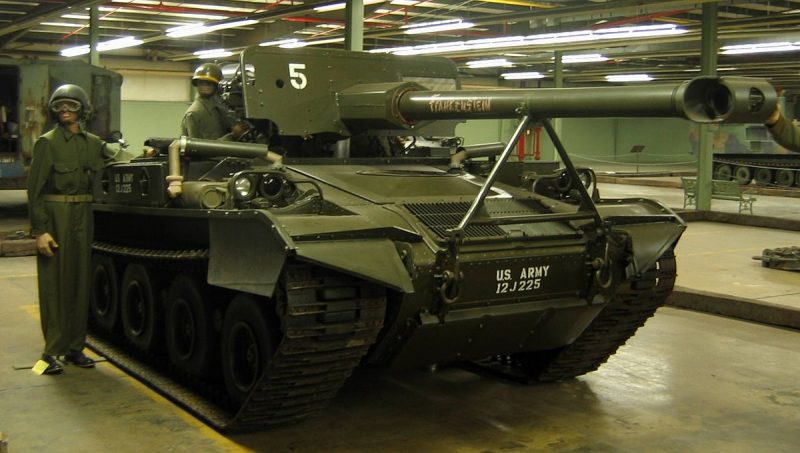The American Armored Foundation Tank Museum in Danville, Virginia, is a family owned and operated museum based in a former milling factory. Inside the 300,000 square foot building are examples of armored fighting vehicles from throughout history.
On display are a rare WWI British tank, a Russian T-34, and an M103. All told there are 52 tanks, plus armored personnel carriers, self-propelled anti-aircraft guns, and howitzers on wheels. There are few places in the world with this many armored vehicles.
In April, they had their Vehicle Run Day, which features a raffle for a chance to ride in an M901 tank. It does not have a turret, but the overall effect of riding in a tank is there.
On September 15th, 1916, the British unveiled their solution to breach the German trenches at the Somme. A British officer recollected the scene. “Lumbering slowly toward us came three huge mechanical monsters such as we had never seen before.”
Those tanks broke down with mechanical difficulties, but the armored vehicle age had begun.
According to Natasha Gasser, tank enthusiasts are a passionate group, but they don’t share the same number of members as groups devoted to combat aircraft and ships. Even the Kevin Bacon movie The Fury, about the crew of a Sherman tank operating behind the German lines, couldn’t boost attendance.
The Gassers need 20,000 paid visitors a year to break even. They average 7,000. “We’re not bringing in enough people,” Dan says. The roof leaks, but would cost $50,000 to fix. They have launched a GoFundMe crowdfunding page. So far, it has received pledges over $1,700.
William Gasser is the founder, curator, and primary fundraiser for the museum. He wears a ponytail, Buffalo Soldier Cavalry hat, and a Colt .38 Special strapped to his hip. He never served in the Army. His father served in the New York National Guard. He has no idea why he is so interested in the military. As a kid, he bought and sold military helmets and uniforms. When he was in high school, he was driving a British armored personnel carrier. In his 20s, he got interested in tanks.
“I was going to quit after I had 10,” the now-64-year-old Gasser said. He is semi-retired from Gasser& Sons, the family company that makes metal housings and cylinders. That business is doing well, which allows Gasser to put millions of dollars into his tank collection. He bought ten that first year and still hasn’t stopped. “That’s typical of collectors: You’ve always gotta have your next high.”
The problem with collecting tanks is that they are not only expensive (some Sherman tanks from WWII can sell for $4 million), they take up a lot of space. In 1981, William turned part of his home in Long Island into the nonprofit Tank Museum. It eventually outgrew the space he had available and became a nuisance to the neighbors. When he moved his family to Danville, they found a run-down factory that the owners donated to him for the tax write-off. The Tank Museum now had 60 acres and a building in which to grow.
Along with 120 military vehicles and large artillery pieces, the museum has rifles, machine guns, bazookas, flamethrowers, helmets and headwear, uniforms, flags, military patches, dioramas, a battlefield for RC tank battles that is 6,000 square feet in size, a black dress worn by Eva Braun, and an autographed photo of George C. Scott from the movie Patton. What the museum does not have is staff. The Gassers do all the work, from cleaning to tank repairs. It takes them two weeks just to clean all of the fingerprints off of the exhibition glass. The museum is kept very clean, but it is only open on Fridays and Saturdays for most of the year.
In 2014 they looked into moving to West Liberty, Ohio, just an hour’s drive from Wright-Patterson Air Force Base, but the deal fell through. If they had made the deal, they still would have needed the several million dollars it would have taken to transport all of the collection there.
William and his wife, Karen, have allowed their children to take over the day-to-day operations of the museum. That means the children are the ones trying to find a way to make the museum support itself. They have more special events. The popular car-crushing demonstrations where a tank from the collection dramatically crushes a car from the local junkyard have been stopped. But, Flamethrower Days are a hit. The country’s top expert on flamethrowers is a family friend. Charles Hobson comes by twice a year to turn mannequin soldiers, a cardboard truck, robot, and giant spider to ash.
But the museum still struggles with finances. Selling the collection, valued at up to $60 million, is not an option. “For us, it’s not a money issue,” says Natasha Gasser. “If it was, we wouldn’t be in the museum business.”
